Pacific FC have enjoyed an impressive start to their 2023 Canadian Premier League campaign, only losing once so far and playing some entertaining football along the way. The Tridents are looking to bounce back after a disappointing 2022 season that saw them finish fourth in the league table and be knocked out of the playoffs at the semi-final stage.
James Merriman, the current manager of Pacific FC, has been associated with the club since 2019 when he joined as an assistant coach. In that same year, he was given the chance to serve as the interim manager towards the end of the season, following the departure of Michael Silberbauer. However, the club later appointed Pa-Modou Kah as the head coach.
Kah, who had a successful playing career with over 180 appearances for Roda JC in the Eredivisie, was instrumental in Pacific FC’s achievements. Under his guidance, the team clinched their first Canadian Premier League title in 2021. Additionally, they enjoyed a notable run to the semifinals of the Canadian Championship during the same year.
Following Kah’s departure in January 2022, Merriman was given the top job and has swiftly gone about implementing his style of play on the club. The players appear to be enjoying playing for him and fans have largely been impressed as the Tridents once again reached the semi-finals of the Canadian Championship this season.
In this tactical analysis which will take the form of a scout report, we will look into Merriman’s tactics and analyse why they have been so effective as we dissect Pacific FC’s start to the current CPL campaign.
Most used formations
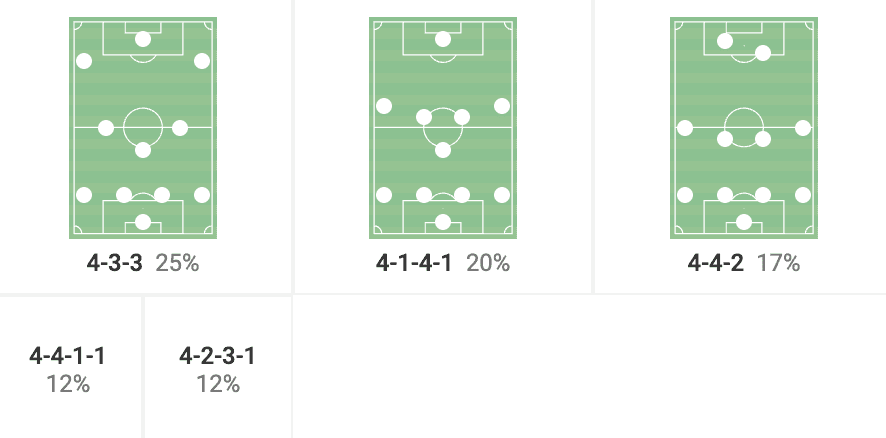
As we can see from the graphic above, Merriman mostly favours a 4-3-3 or a 4-1-4-1 formation. The two are largely interchangeable and more often than not, Pacific will adopt the latter formation as their shape when in the defensive phase as it means the wide players track back and ensure there are fewer spaces for the opposition to exploit.
In terms of attacking play, a 4-3-3 formation is well-suited for quick transitions from defence to attack. With three forward players, Pacific FC are ready to initiate counter-attacks swiftly once possession is regained. The central midfielders provide support and link-up play, allowing for rapid progression through the midfield and exploiting any spaces left by the opposition during the transition.
Unselfish play in the final third
Since Merriman has taken the reins at Pacific, there has been a great sense of freedom flowing through their attacking play. This has played such an important role in their attacking performances this season which has seen Pacific FC score 19 goals in nine games thus far.
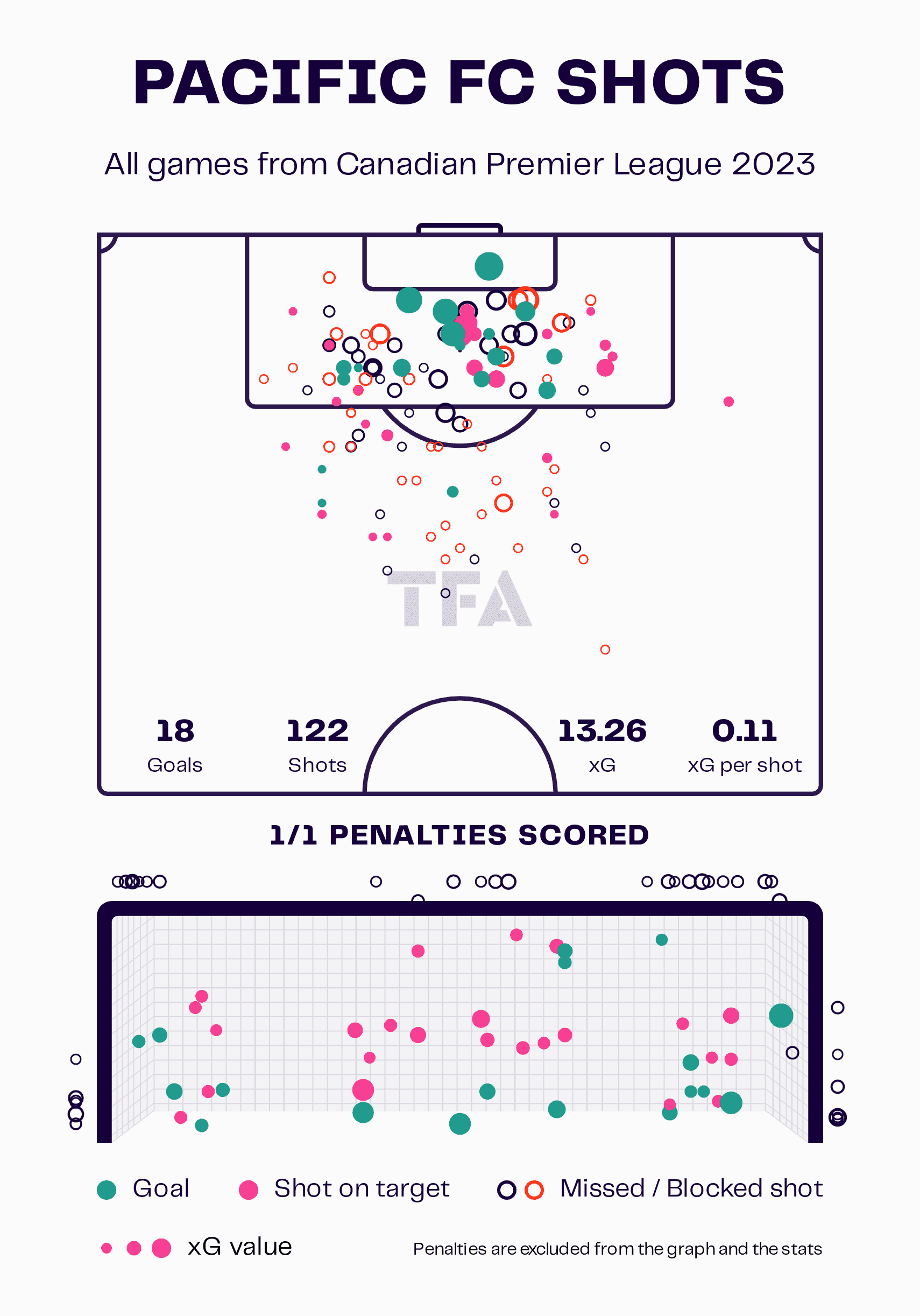
The data visual above shows just how clinical the Tridents have been so far this campaign, scoring 18 non-penalty goals from an xG of 13.26 which indicates not only are they scoring low percentage chances, they are creating plenty of opportunities, with 122 so far this season.
A key element of why Pacific have scored so many goals this season is simple: unselfishness, or if we were to quote Ted Lasso, ‘making the extra pass’. Being unselfish in the attacking third really allows players to create better scoring opportunities by making intelligent decisions to pass the ball to a teammate who is in a better position to score. This enables the team to exploit gaps in the opposition’s defence, create numerical advantages, and generate higher-quality scoring opportunities.
Moreover, this also plays a pivotal role in facilitating quick combination play. By passing the ball to better-placed teammates, Pacific FC are able to execute one-touch passes, quick give-and-goes, and intricate link-up play. This fast and precise passing can very often destabilise the opposition’s defence and create opportunities for scoring goals as we will discuss.
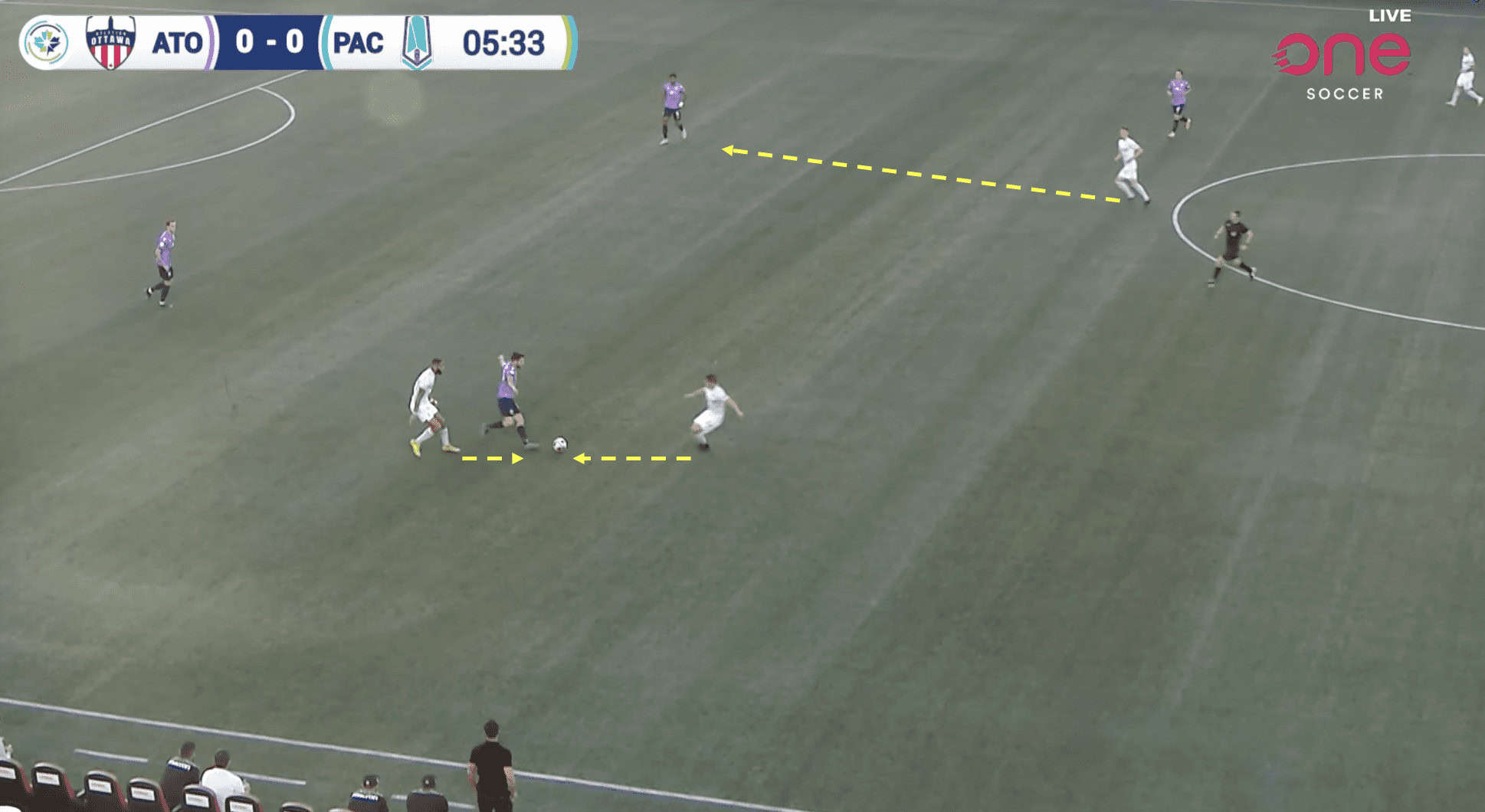
Here, we can see that Pacific does engage in a press, though it must be stated they are not a high-pressing team. The Tridents have a PPDA of 12.87 which is below the league average of 11.1 and well below the likes of Calvary FC and Valour FC who have a PPDA of 6.87 and 7.72 respectively.
Merriman’s team will only look to press when they believe a goal-scoring opportunity can be created. In Figure 1.1, we can see that Manny Aparicio and former PSV youth player, Djenairo Daniels want to prevent Atlético Ottawa from playing out and have initiated a press. Pacific FC regains possession and very quickly counterattacks.
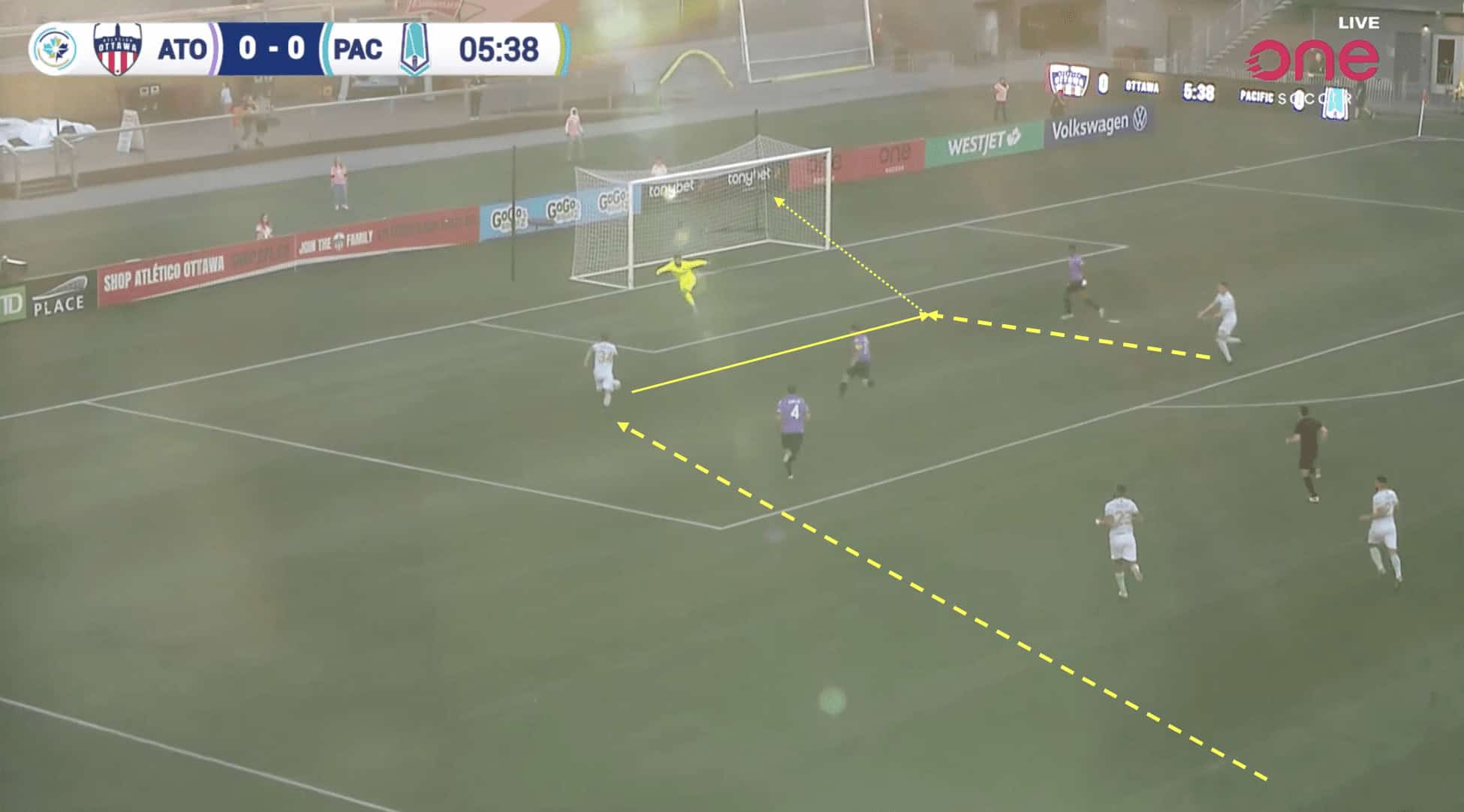
In Figure 1.2, we can see that Aparicio has carried the ball into the opposition’s penalty area. In such a situation, most players would typically opt to go for goal themselves, considering options such as placing a shot into the corner or chipping the goalkeeper as he goes to ground. However, Aparicio makes a different choice, instead of shooting, he chooses to pass to Sean Young, who finds himself in a much better position to score an easy tap-in.
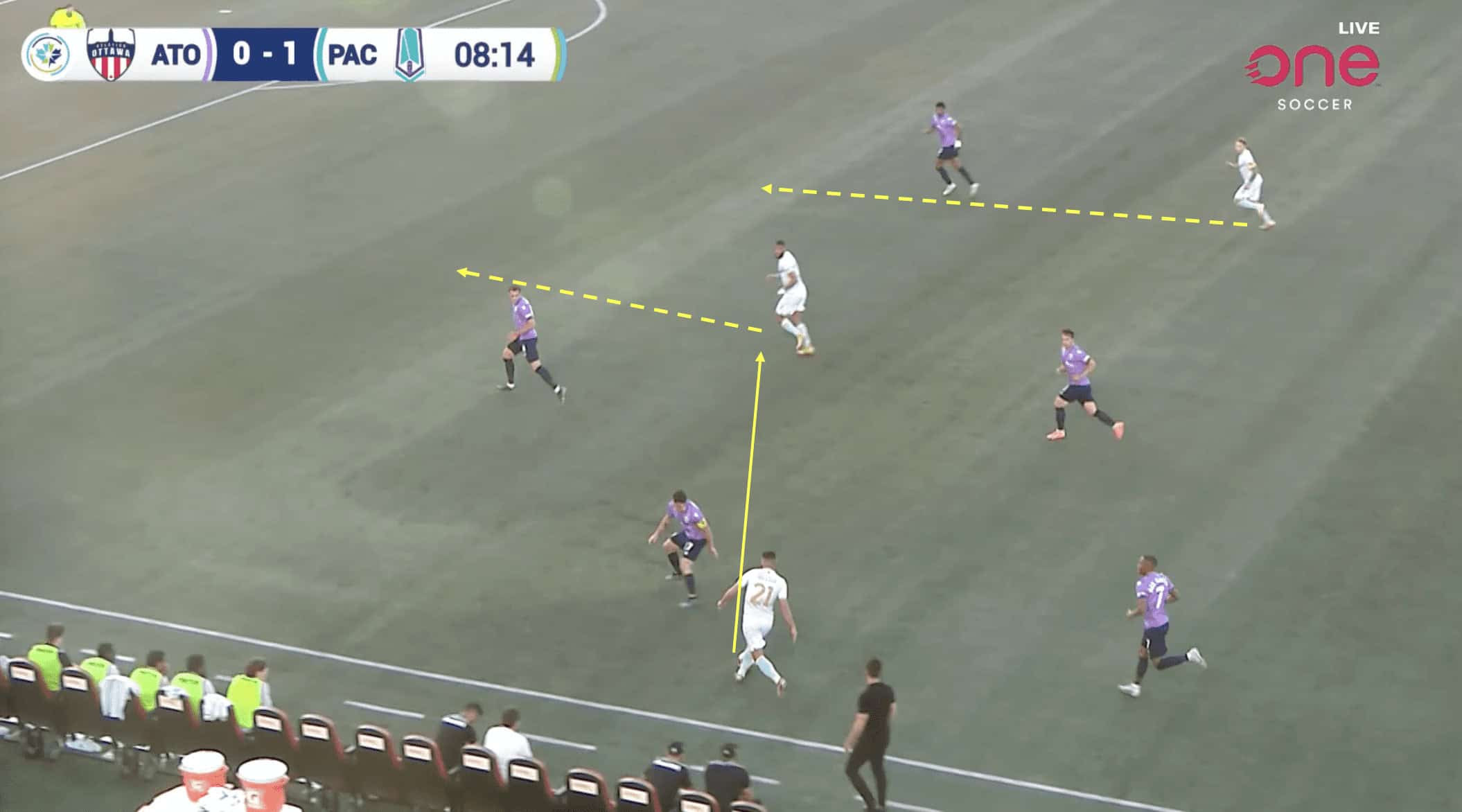
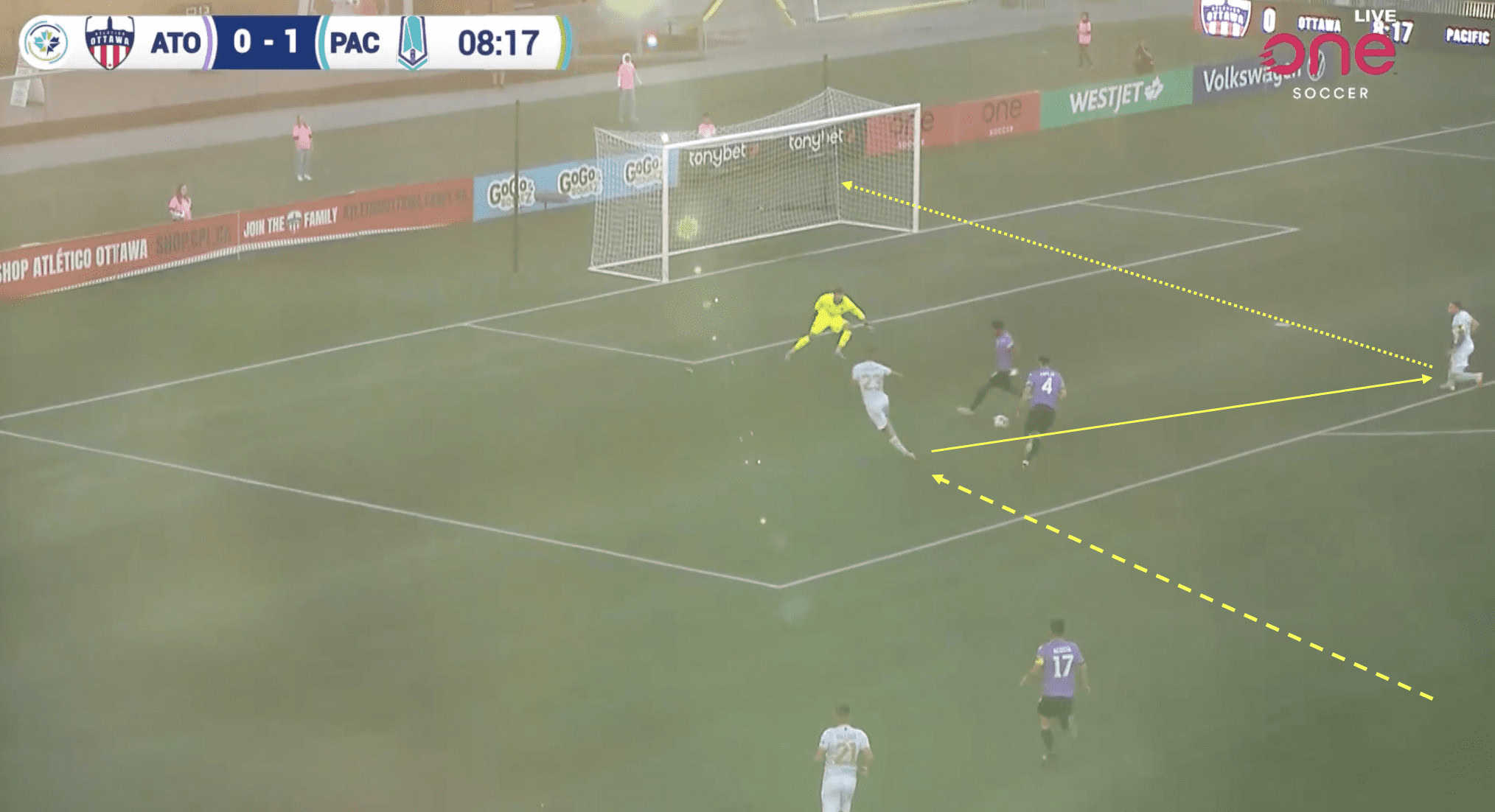
Here, in Figures 1.3 and 1.4, which occur three minutes after the previous images, a similar scenario plays out. Ayman Sellouf, who has enjoyed a wonderful start to the season, plays in Daniels who carries the ball into the opposition penalty area, just as we saw with Aparicio. As we can see in Figure 1.4, Daniels chooses to play the ball across to Josh Heard who is there to pass the ball into an empty net. This goal is almost identical to the one scored three minutes prior.
Dynamic build-up play
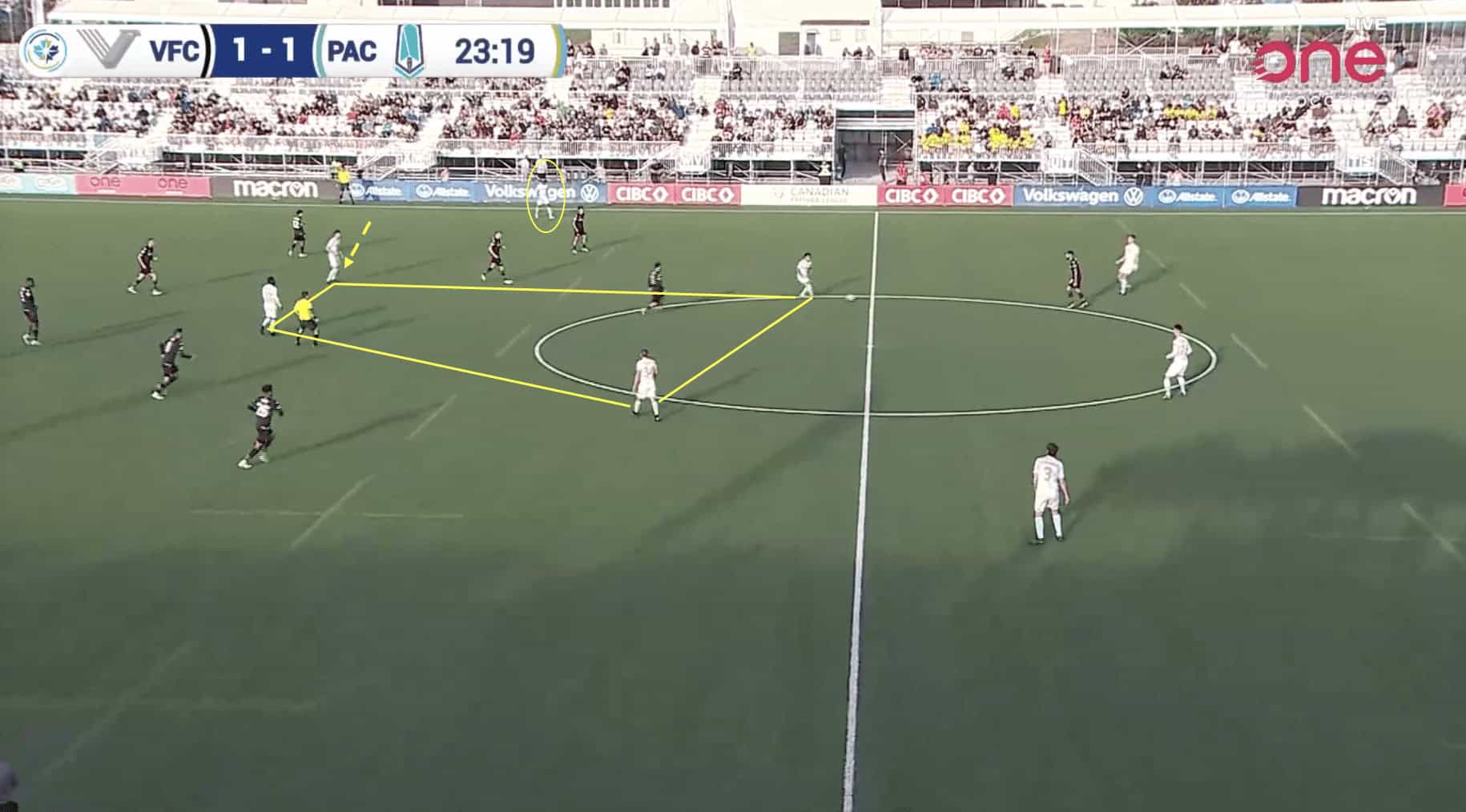
In the attacking phase, Pacific FC heavily relies on the fluid off-the-ball movements of its players, which enable dynamic build-up play. In this particular game against Vancouver, shown in Figure 2.1, Merriman chose to use a 4-4-1-1 formation.
We can see that Sean Young, who is typically a box-to-box midfielder, played as the right winger in this game and actively drifted in from the right flank. He formed a narrow box shape with the two defensive midfielders, positioning himself alongside Adonijah Reid, who played as the number 10. This drew the opposition into the central areas and ensured that right-back Olakunle Dada-Luke, who usually completes an average of 2.62 progressive runs per 90 minutes, had plenty of space to exploit on the right flank.
Furthermore, we can see that during the initial build-up play, Dada-Luke positioned himself much higher than his counterpart at left back who formed a back three alongside the two centre-backs.
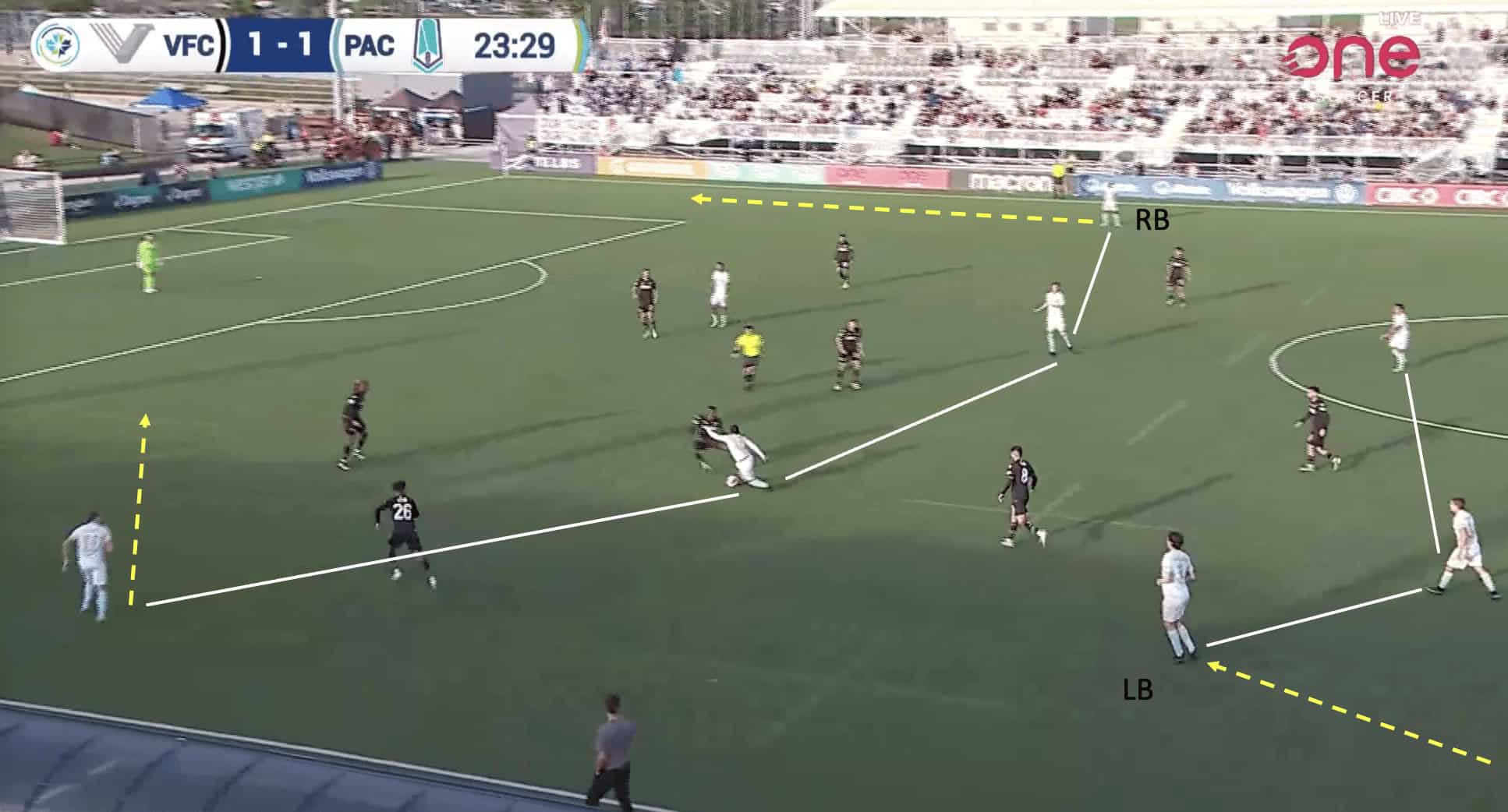
Here in Figure 2.2, we can see that as the build-up play progresses through the lines, the left back moves up to join the defensive midfielders and right back Dada-Luke forms a four-man attacking midfield alongside Sean Young, Adonijah Reid and Josh Heard.
With the two central defenders remaining in their positions, this means that Pacific’s shape has now evolved into a 2-3-4-1 shape in the attacking phase which of course allows them to firstly play through the lines and secondly exploit the wider areas. As we can see, Dada-Luke is more likely to remain in the wide right area whilst Josh Heard, who is the left winger, looks to make inverted runs into the penalty area.
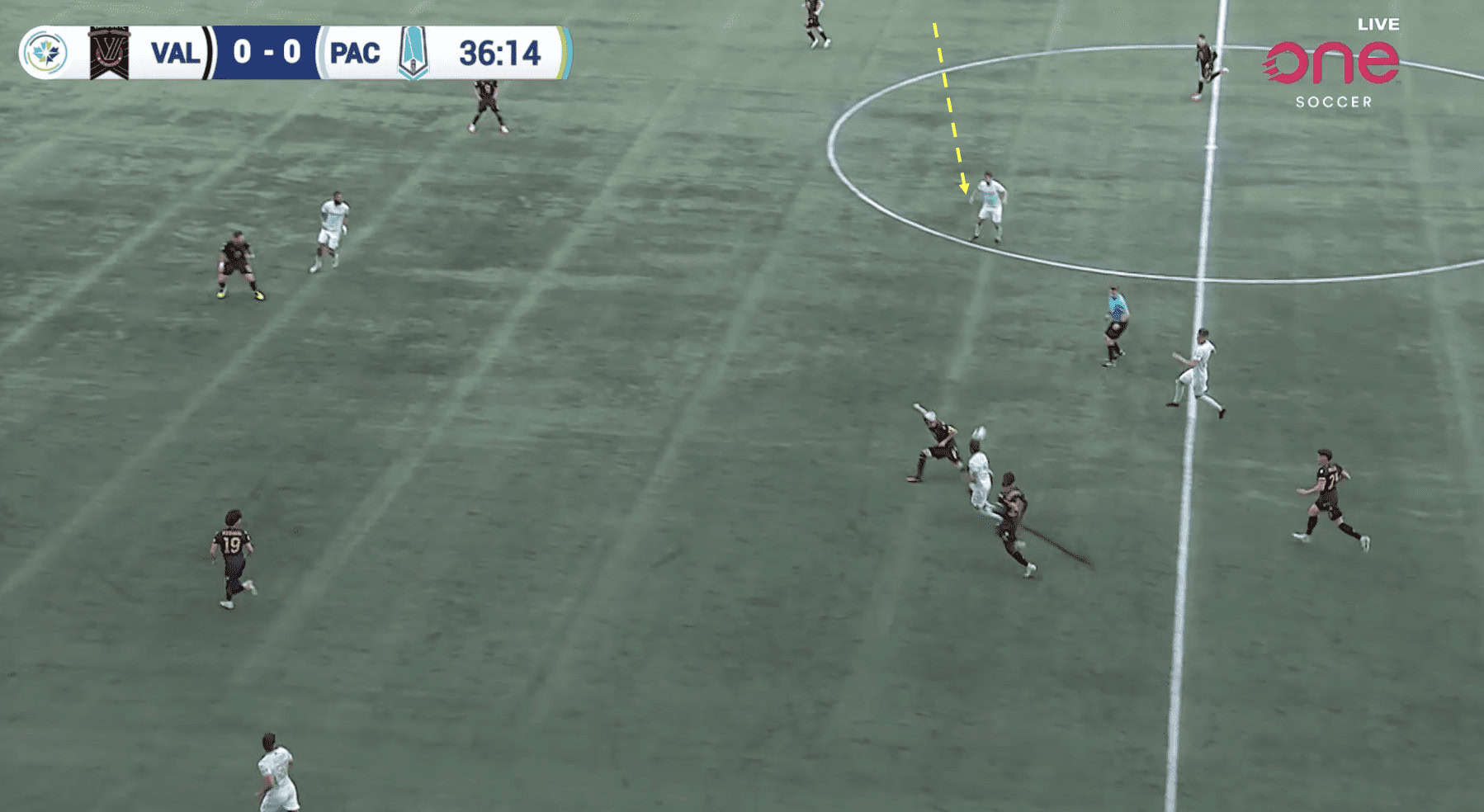
The tactical emphasis on the right back to maintain a high and wide position during the attacking phase creates opportunities for the player in the right-wing role to roam into central areas. This strategic move aims to attract more opposition players away from the wings, creating space and opening up passing lanes for the team. In Figure 2.3, we can see David Brazão, who has ventured into the central midfield area as Pacific FC builds an attacking move. This movement helps create numerical superiority in midfield and allows for more dynamic and flexible build-up play.
By operating more centrally, he has access to a wider range of passing options; he can play incisive through balls, diagonal passes, and quick combinations with teammates in different positions. This increased passing variety can unlock the opposition’s defence, break the lines, and create openings for goal-scoring chances. Furthermore, this positional flexibility allows seamless transitions between different formations and tactical systems throughout the game. It is this versatility that makes it difficult for opponents to predict Pacific’s movements and defend against them effectively.
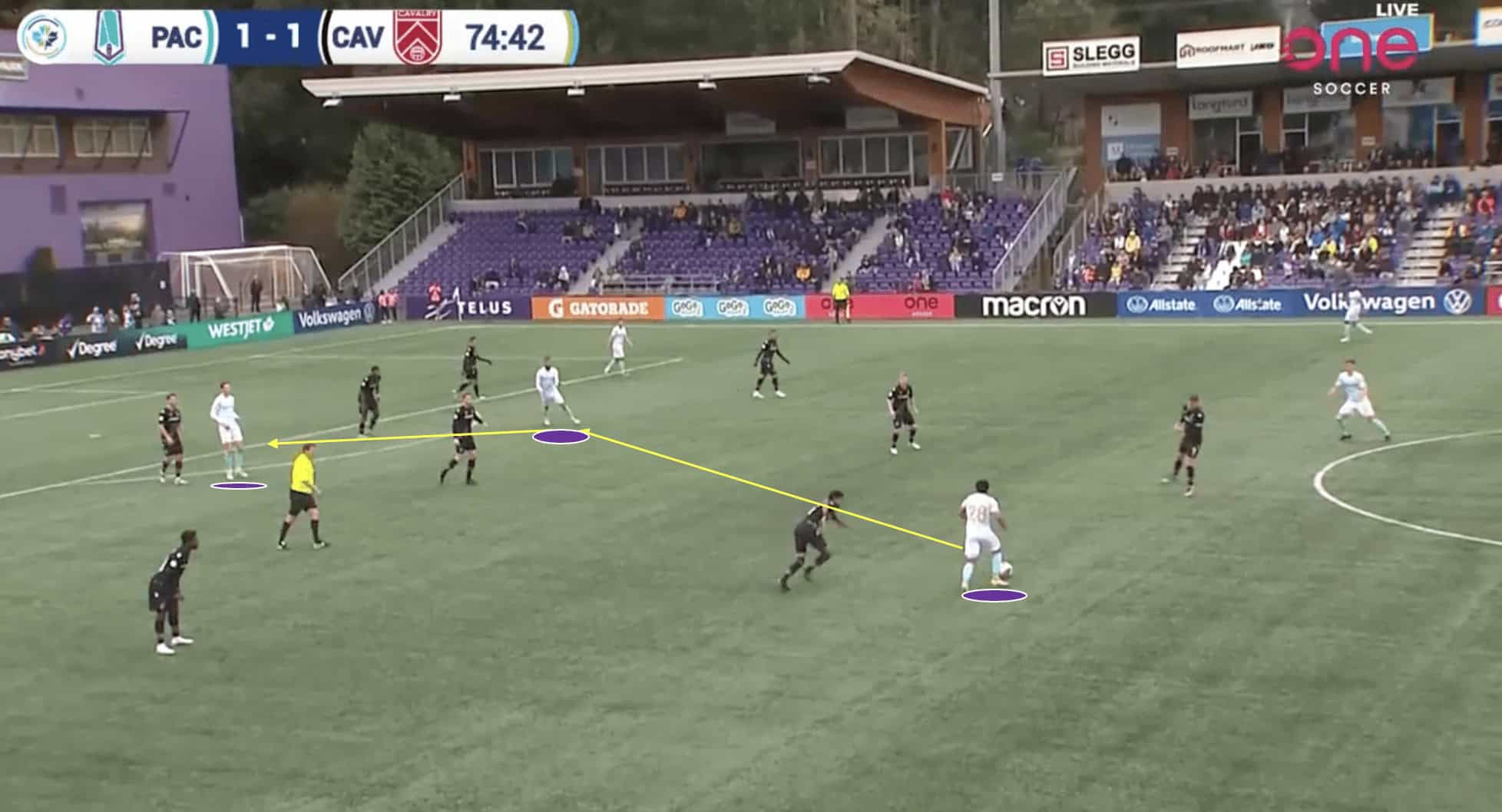
Under Merriman’s leadership, Pacific FC are unpredictable in the attacking third. As we have seen, sometimes they will press high to catch the opposition off guard. Other times they will play down the wings. Additionally, they will look to play through the central areas, as shown in Figure 2.4.
This makes it difficult for the opposition to anticipate and defend against the team’s attacking moves. By introducing variation in the team’s play, such as changing the tempo, direction, or style of attacks, the opposition defenders are forced to constantly adapt and react. This can create confusion in the defensive structure, and open up spaces for the Pacific players to exploit.
Here in Figure 2.4, we can see Pacific building up through the central areas using intricate passing and off-the-ball movements. Toussaint is in possession and plays an accurate ball into the striker Djenairo Daniels’ feet, he then executes a nice pass around the corner into Young who has moved much further up the pitch from his midfield role. When Pacific exhibits such a wide range of attacking options, it becomes challenging for the opposition to solely focus on shutting down one particular player or shutting down specific areas of the pitch. This is what creates space and opportunities for other players, such as Sean Young, to shine and contribute to the team’s attacking play.
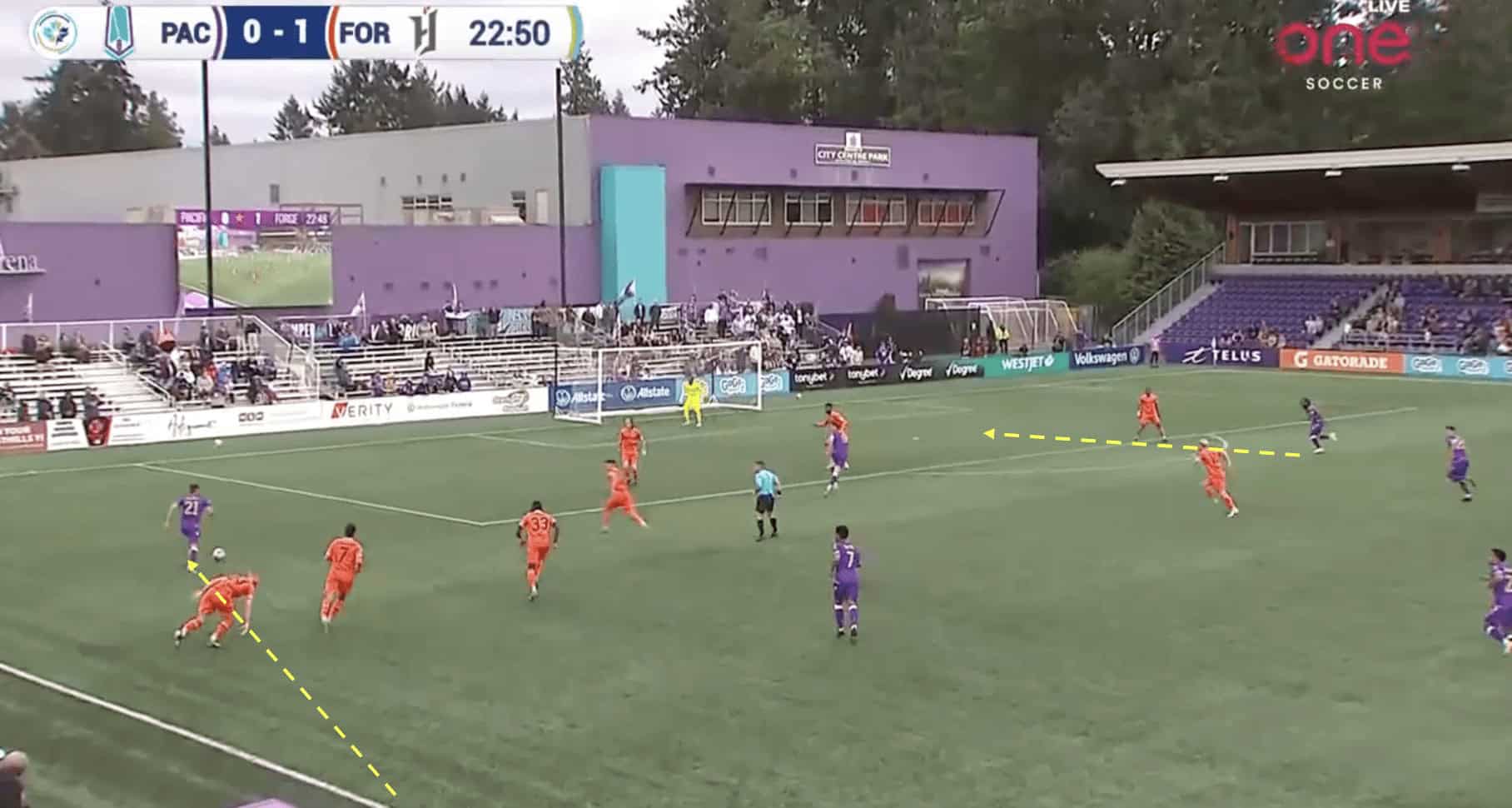
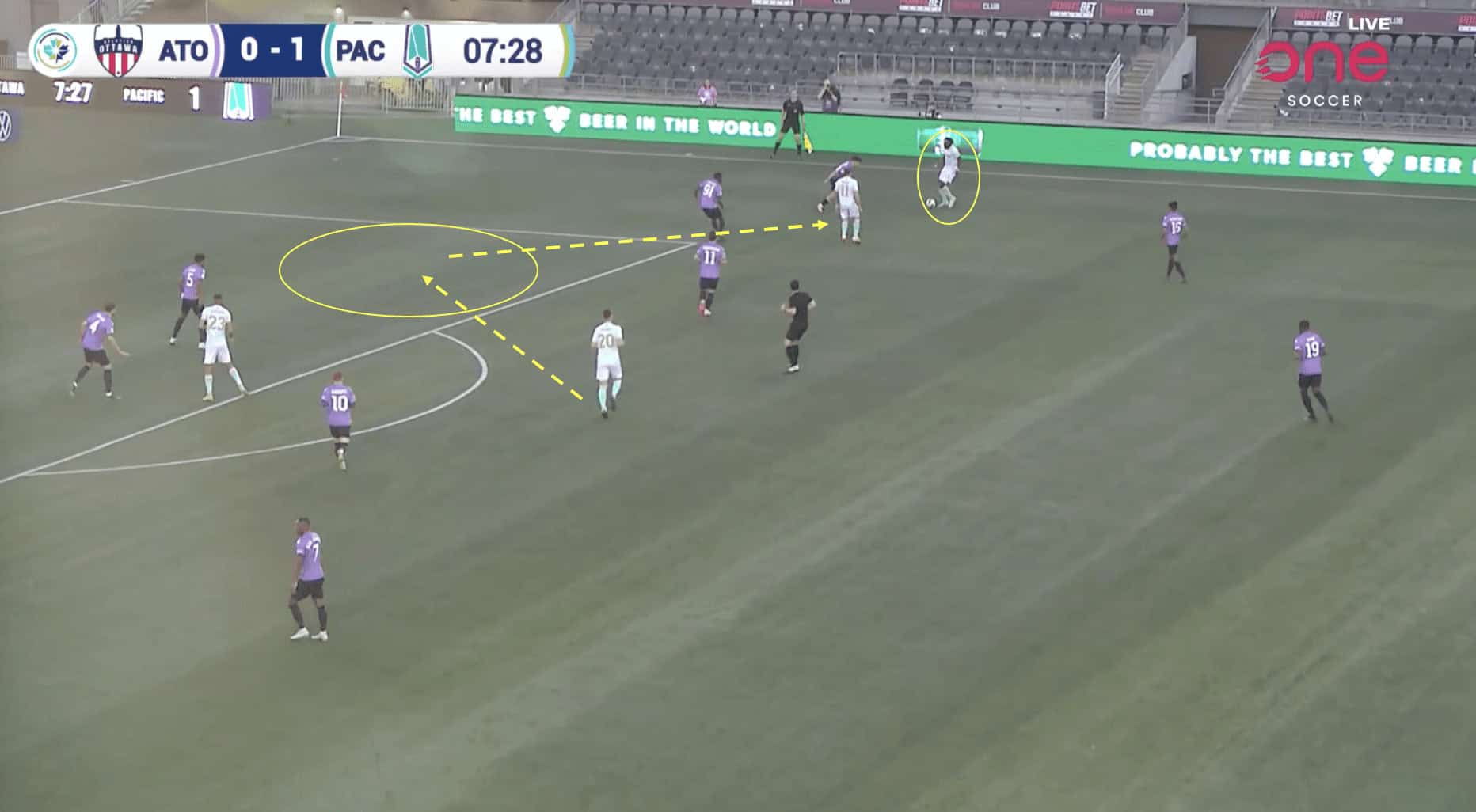
As mentioned previously in this scout report, Pacific FC look to use the wide areas, not necessarily to put crosses into the box as they only have a 34% accuracy rating per 90 this season. Instead, they like to draw the opposition out to the wide areas which leaves spaces for midfield runners into the penalty area.
In Figure 2.5, we can see that left-winger Sellouf has dribbled his way beyond several opposition players and is looking to carry the ball into the penalty area. Additionally in Figure 2.6, we can see that Dada-Luke has possession out on the right wing and Josh Heard has gone out to offer him the option of a short pass or a quick one-two as a possible way of creating space. Additionally, Heard vacating the penalty area leaves space for Sean Young to potentially run into which is in keeping with Merriman’s desired rotations in the attacking phase.
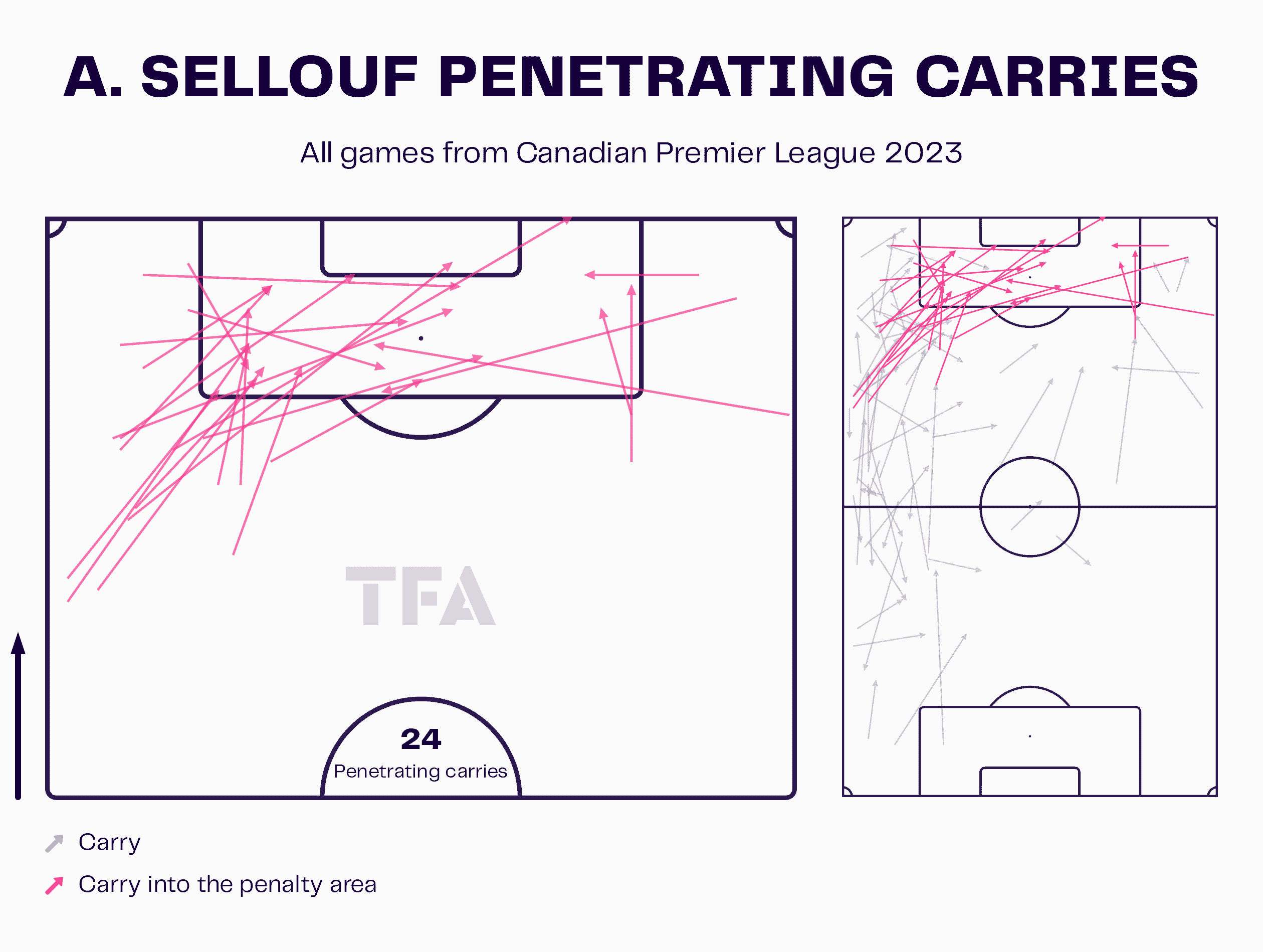
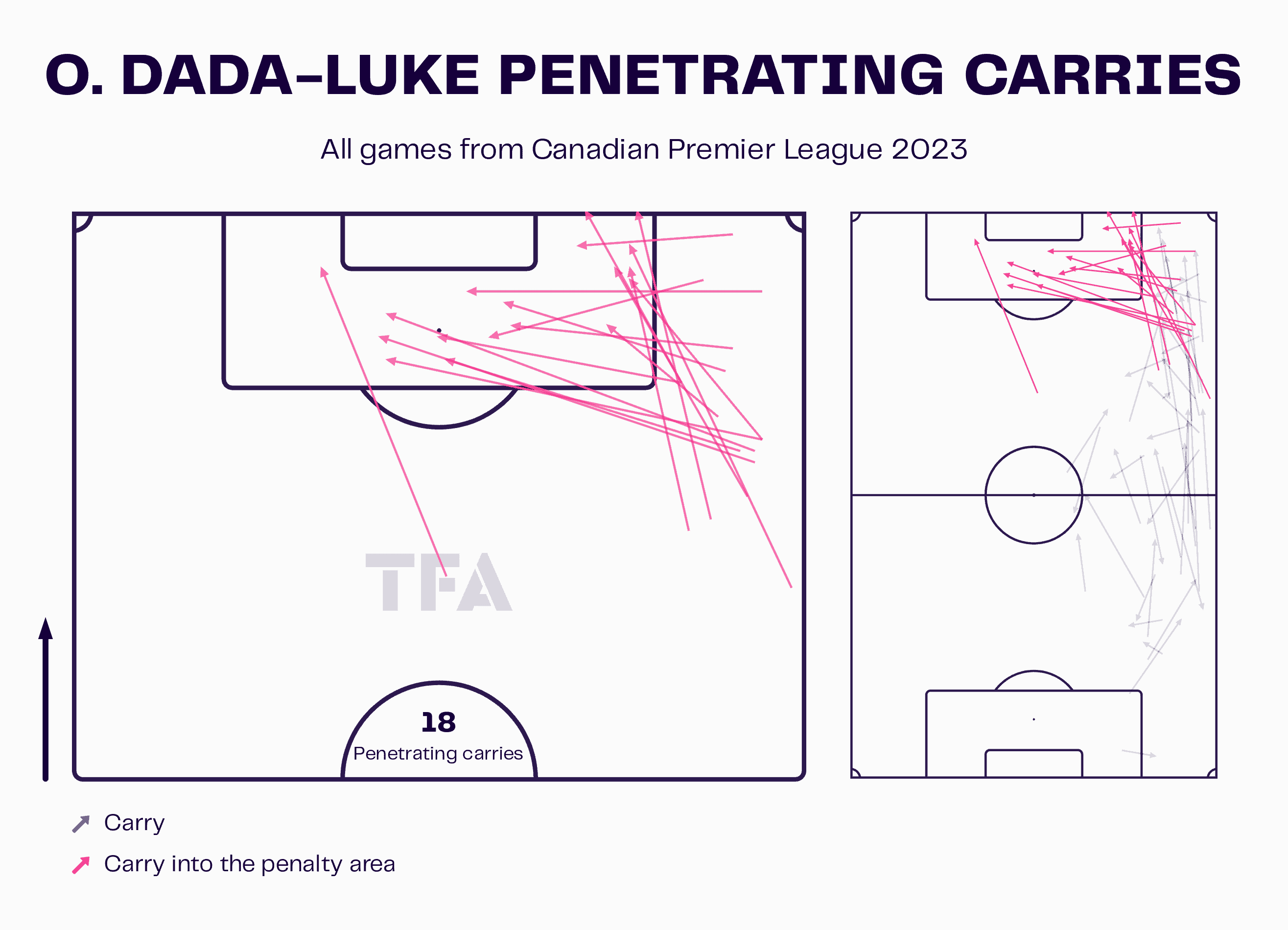
Sellouf and Dada-Luke have received significant attention in this analysis due to their crucial roles in James Merriman’s tactical approach at Pacific FC. Both players have been instrumental in the team’s style of play.
The data visuals above demonstrate that both Sellouf and Dada-Luke excel in making penetrating runs into the penalty area while maintaining control of the ball. Sellouf has already contributed 24 in the current season, showcasing his ability to break through the opposition’s defence and create scoring opportunities. Similarly, Dada-Luke has made 18 penetrating runs into the penalty area, highlighting his attacking prowess from the right-back position.
Ayman Sellouf averages 10.17 dribbles per 90 and is successful in 49.2% of them. He also averages 5 progressive runs per 90 and 2.41 shots per 90 meaning, overall, he is very productive in the attacking third for Pacific. Turning our attention towards Olakunle Dada-Like, he has been averaging 4.07 dribbles per 90 with a success rate of 67.9% which is partly what makes him such a key player in Pacific’s build-up play in addition to his speed and link-up play.
Defensive discipline
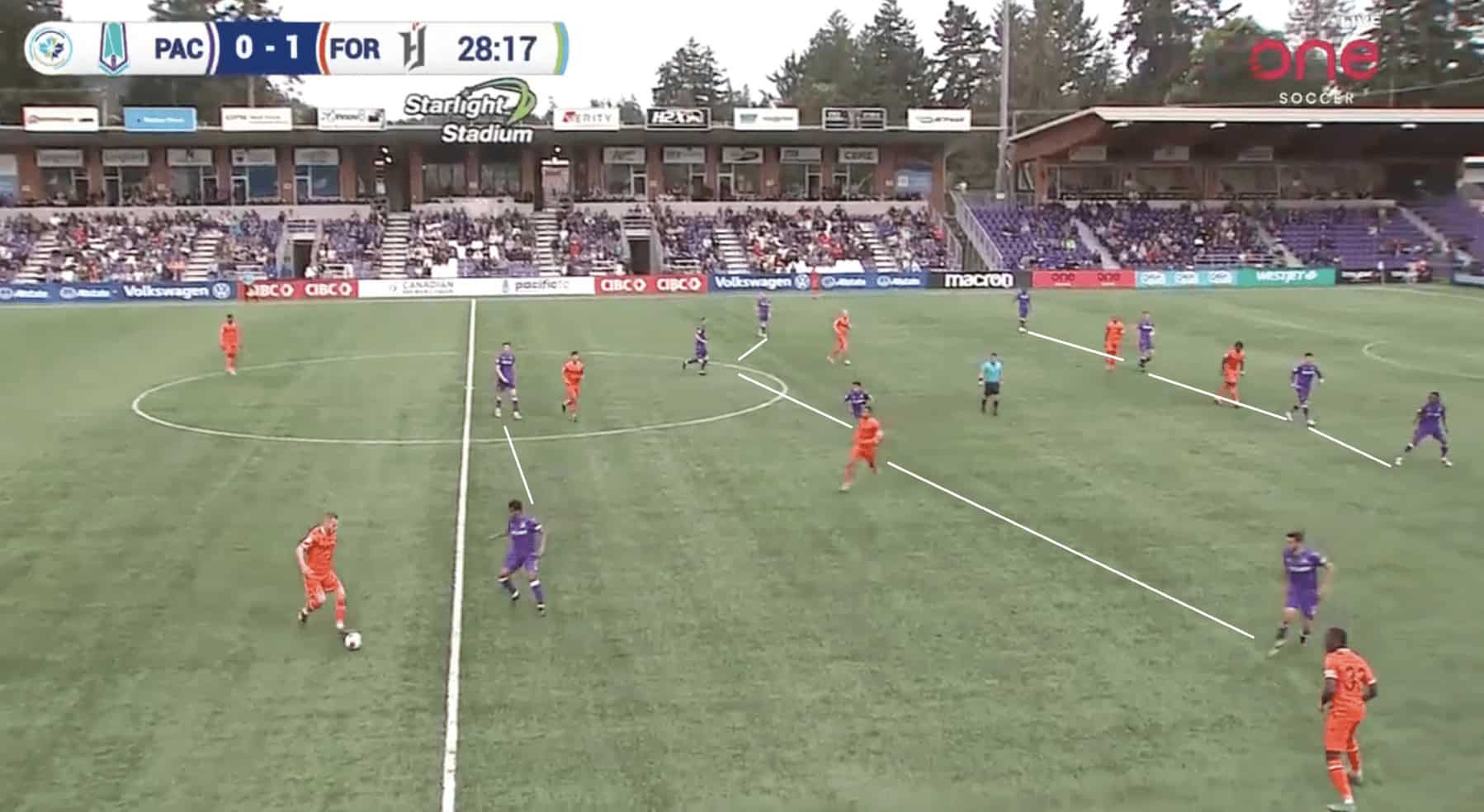
We have established that Pacific FC have the freedom of expression in the attacking phase, with Merriman encouraging dynamic movements and intricate passing. The Tridents are proving to be much more controlled and disciplined in the defensive phase though. Having only conceded 9 goals so far this season, Merriman will undoubtedly be pleased that his team boast one of the best defences in the league.
As we can see in Figure 3.1, when the opposition is looking to build an attack from the back, Pacific quickly falls back into a 4-4-2 shape. This shape provides a solid and compact defensive structure – with two blocks of four defenders and four midfielders positioned in front of them, the team can effectively cover and protect the central areas of the pitch. This compactness makes it much more difficult for the opposition to find gaps and penetrate through the middle, forcing them to play through the wide areas or attempt longer passes.
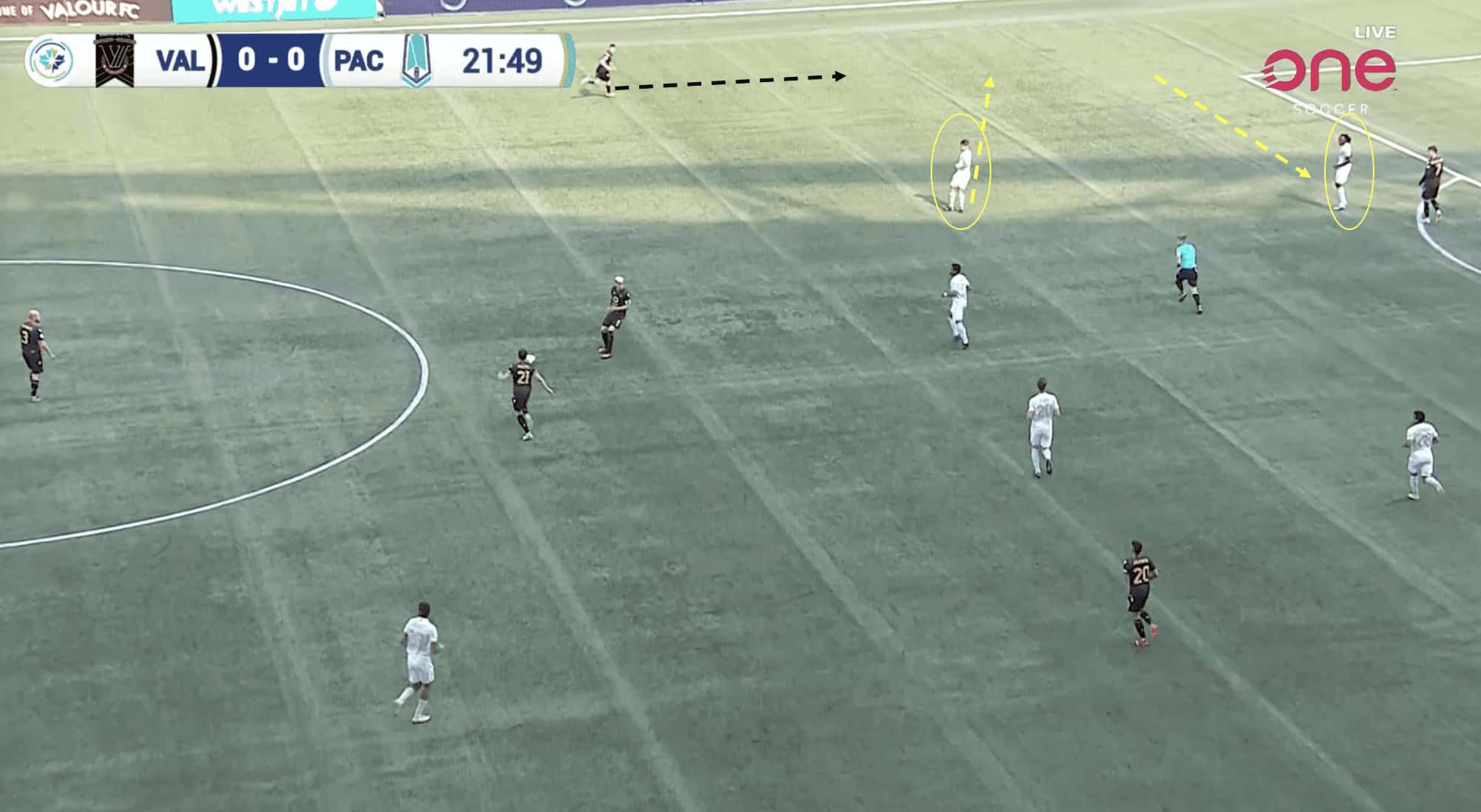
Moreover, with Merriman at the helm, the players seem to really buy into his tactical style and are willing to put in the hard graft in the defensive phase of play. We can see in Figure 3.2 that when the opposition does manage to play through the lines, the full-backs, in this case, we can see the right back, will tuck in and form a compact block of four defenders while the wingers will track the runners out wide.
With four defenders positioned in a flat back four, Pacific can outnumber the opposition in this crucial area. This can make it difficult for the opposition to work their way into the penalty area via individual progressive runs or passes meaning Merriman’s team are less likely to concede.
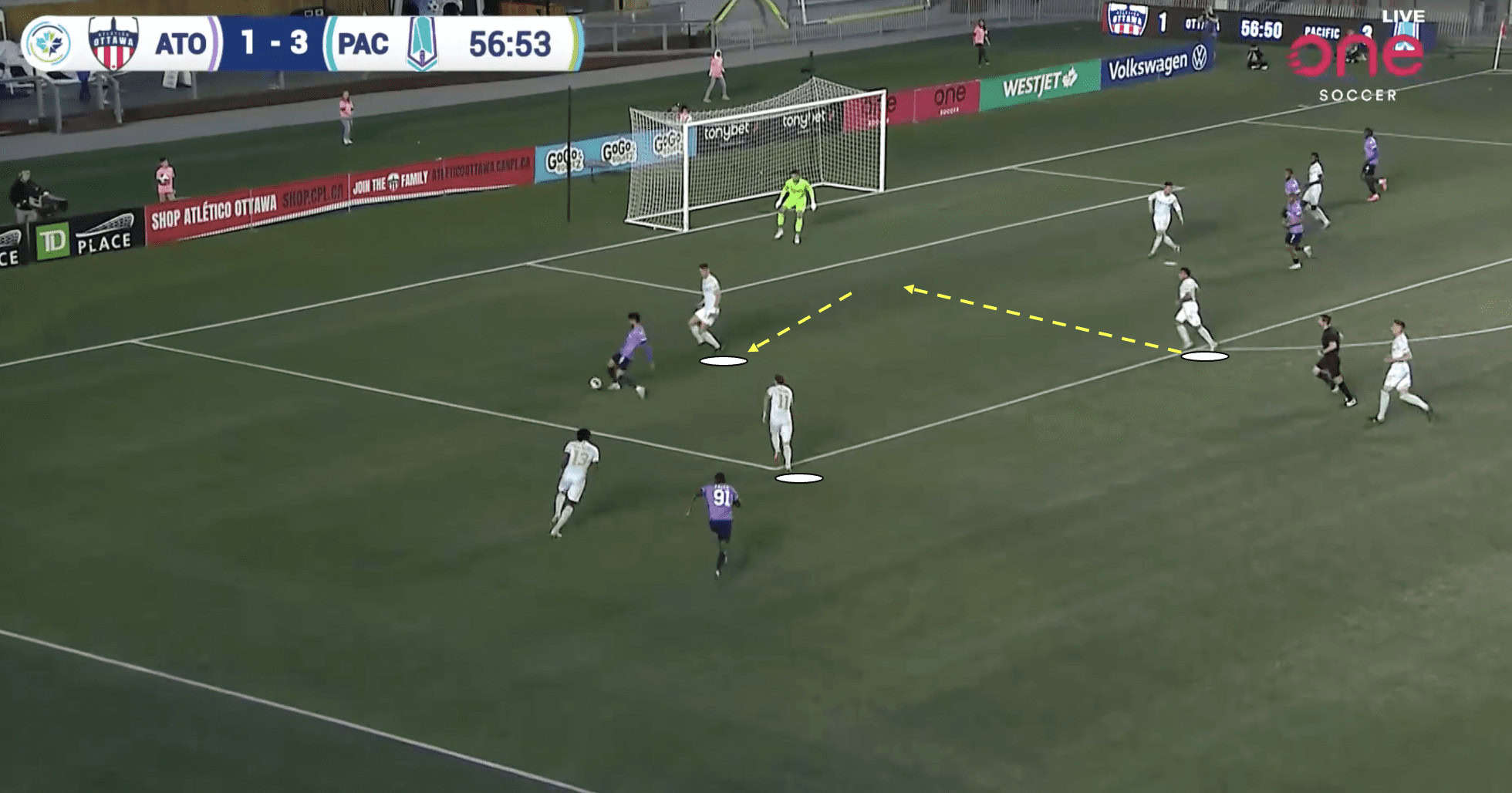
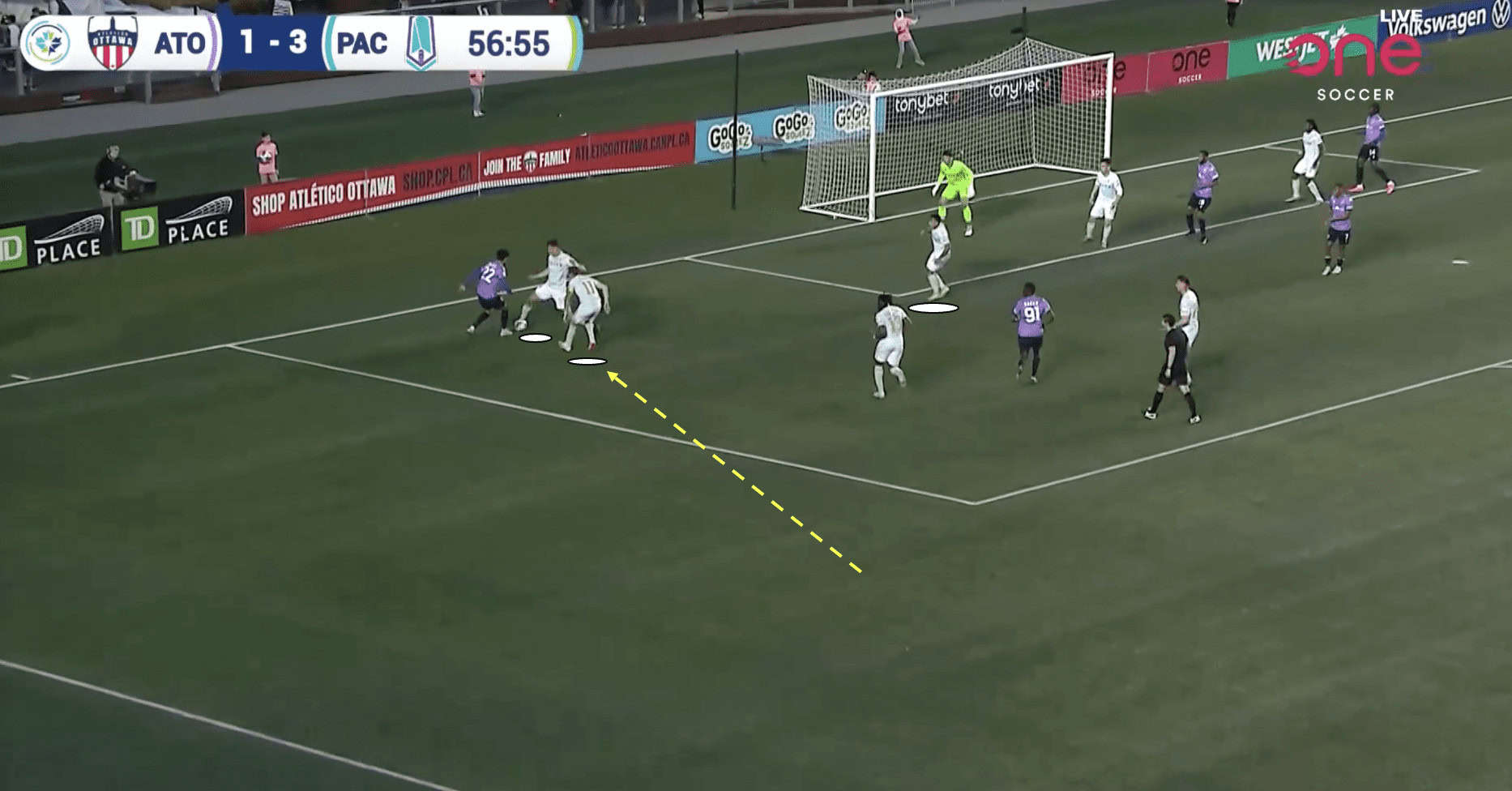
Furthermore, Pacific FC have showcased some very effective low-block defending this season as we can see in Figures 3.3 and 3.4. When forced to defend just in front of their own goal line, the Tridents maintain a solid defensive shape which ensures there is less space for the opposition to exploit in the final third. This makes it difficult for them to penetrate through the defensive lines and limits their scoring opportunities.
Additionally, Pacific’s low-block defence can frustrate the opposition and disrupt their attacking rhythm. By denying them space in the final third and blocking passing lanes, it forces the opposition to play in front of the defence or resort to speculative long-range shots. This approach can lead to impatience, poor decision-making, and frustration among the opposing players. The lack of clear opportunities or penetrative passes can cause the opposition to become increasingly desperate and prone to making mistakes or turnovers.
Conclusion
The Canadian Premier League is still in its infancy as a league, but it has shown continuous improvement year after year. Clubs within the league are demonstrating their willingness to provide opportunities to young coaches. For instance, as we know, Pacific FC appointed 38-year-old James Merriman as their coach, while Atlético Ottawa, an Atlético Madrid-owned club, appointed 37-year-old Carlos González who went on to be named Coach of the Year for 2022.
James Merriman has clearly implemented his own distinctive style of play since taking on the managerial role at Pacific FC. His approach focuses on fluid movements and dynamic play, combined with a strong work ethic and a selfless attitude rarely seen on the football field. This tactical style allows the team to bring out the best in their players and maximise their potential.
As a consequence of this, Pacific FC is enjoying a great start to the Canadian Premier League season and could find themselves challenging for the title once again as they look to build on recent results.
James Merriman is proving to be a wise appointment and, should he continue to impress, it may not be long before other North American clubs, such as those in the MLS, take notice of the talented manager.





Comments